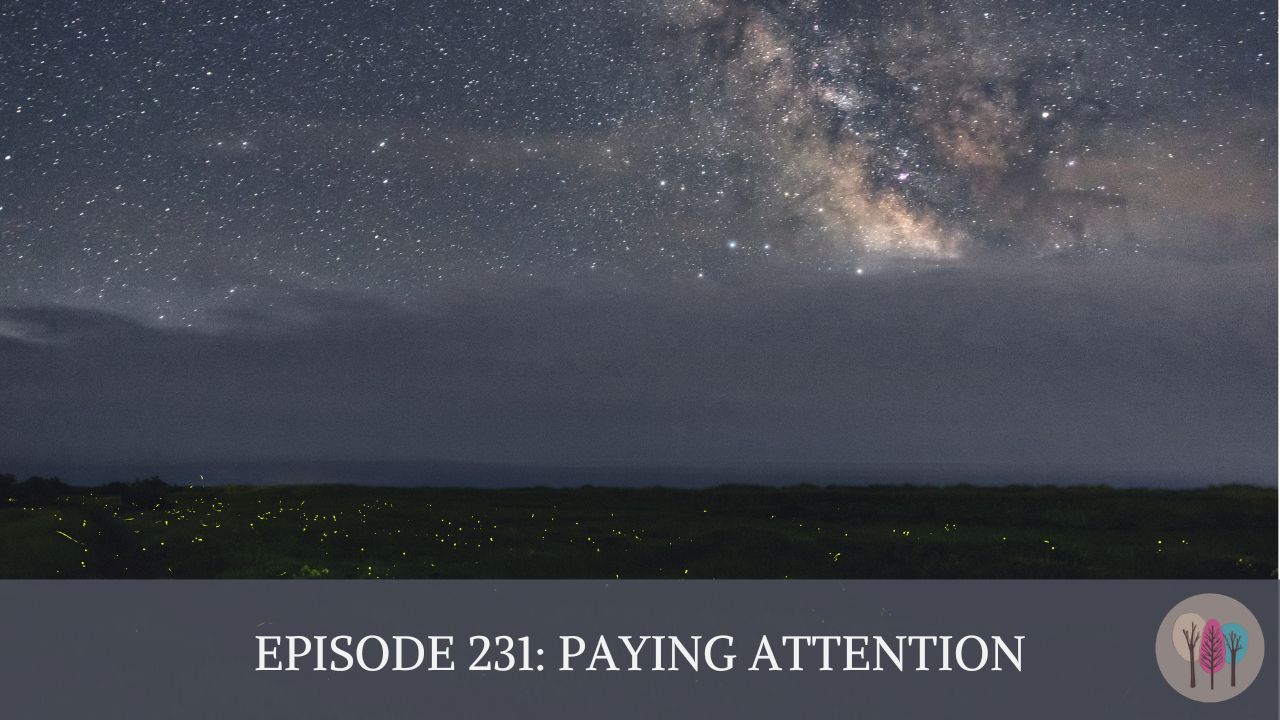What is the purpose of Lent? Learning to pay attention. And what is the purpose of paying attention? Being present to God and each other and all of creation. And what happens when we pay attention and become more present to God and the world around us? We are transfigured into people fully alive as God intends humans to be. We are made for this kind of holy paying attention, this becoming fully ourselves.
Why then so much resistance?
Everything around us begs us to pay attention to it.
Music. Media. Movies. Work. Kids. House. Church. War. Injustices. Racism. Climate crisis. News. Chores. Sexism. Deadlines. To do lists. Homework. Chores. The many demands of everyday life all around us can be a pathway to learn the practice of paying attention. Or they can be complete distractions and diversions. Sometimes they are both.
Simone Weil writes about attention and prayer in her classic essay “Reflections on the Right Use of School Studies with a View to the Love of God.” She says,
The Key to a Christian conception of studies is the realisation that prayer consists of attention. It is the orientation of all the attention of which the soul is capable towards God. The quality of attention counts for much in the quality of the prayer. Warmth of heart cannot make up for it.
Let’s take music for an example. We can listen to music, and it can teach us to pay attention. From paying attention to music, including its context and composers, we can learn about the contours of desire and longing, grace and forgiveness, love and loss. And so much more.
Or we can listen to music to distract us from actually paying attention to anything. It can be an escape. A defense or a pretense. An avoidance of God, ourselves, and other people.
Thus an important early task in paying attention is deciding to what we will give our attention. Yet even when we decide where to focus our attention? More problems soon present themselves.
Everything in us wants to protect our vulnerability.
To pay attention to our own feelings, pain, disappointment and deep senses of pleasure and joy can be an overwhelming experience. To see ourselves unflinchingly and know ourselves honestly will push us toward change.
Transfiguration of one’s heart and mind requires a precondition of courage and openness. That kind of life-altering change is not up to us alone. It is an encounter with the holy. It is not simply change for change’s sake or to draw attention to our selves, to prove a point, or make a mark. Rather transfiguration that comes from sustained prayerful attention is rare and not reducible to any formula or set of spiritual rules or tricks.
A few years ago for Lent, I embraced a practice of paying attention to my anger. It was a full-time job. I did not simply want to fan the flames of my rage or suppress or control my frustrations. I wanted to really pay attention to it because anger is a sign that something needs to change. And often it is me. But it may not be the kind of change you are imagining.
In that Lenten season, I was using a process over and over each day. (Anger shows up a lot in me.) It is a process that I teach my students and mentees. It invites discovery of meaning and purpose through starting with the question:
What makes you angry?
When you are clear about what makes you angry you have a chance to turn that feeling around in your hand and to ask a deeper question. It requires careful paying attention.
What deeply held value or conviction is being violated in this thing that makes me angry?
Being Present to Ourselves
When I was present to the feelings of anger rather than trying to suppress or avoid them, when I was curious about the source of that anger without trying to redirect my feelings too quickly, I could see into the values I hold most dearly and refocus my energy on supporting those values (mutuality, collaboration, careful listening) in my life and work.
It was a slow transfiguration of anger that has been a deeply held defensives structure throughout my life. But gradually I shifted from being a victim of my own defensive anger to becoming a witness.
Augustinian priest and professor of early Christian studies, Martin Laird, also writes about attention. In his first book about contemplation, Into the Silent Land, he says:
“One of the fruits of interior silence is precisely this growth in awareness. Growth does not mean that somehow we are no longer going to struggle with our issues. Much struggle remains with us for a very long time. But what does change is how we experience the struggle. We are able to see with greater clarity what is going on within us as it is happening. Remove from being a victim of what is happening to being a witness to what is happening.” Into the Silent Land (80-81)
To pay attention in the season of Lent, and through every season of our lives, then is to look thoughtfully and with courage at our interior feelings and experiences. Rather than be a victim to all our internal machinations, we can become instead a witness to our experiences, even the most troubling or terrifying.
Everything in the world asks us to pay attention to vast, complex and overwhelming needs.
The troubling and terrifying are not merely in our minds or hearts. The world is overrun with both. When the terrible and the troubling and the traumas of our time make the headlines and fill our social media and dominate the news cycle, we can be totally overwhelmed with what to do in response to all of that need and hurt.
When we rush to judgment, we can miss the complexity and contribute more overwhelm in the situation rather than be a participant in its healing. We become another victim rather than a witness to the harms in the world around us.
I read a story on social media recently that illustrates the challenges of paying attention to a vast, complex, and profoundly broken world.
This person has been vocally calling for an end to taking innocent lives in Gaza. This person, whom I respect, is lamenting the loss of Palestinian lives, especially those of children. They went to an action to support this cause and managed to take a seat among a group of people from a very different camp of counter-protesters.
My friend ended up in a conversation with a Jewish person who was among the counter protesters. The conversation revealed profound reasons that the Jewish individual was experiencing genuine fear, anxiety, and a sense of profound unsafety. Everyday this American of Jewish faith carries all of these and more feelings in their soul.
Staying in the Conversation
By staying in the conversation, paying attention, and taking a risk to be curious (not defensive or argumentative), my friend came to new insights and understanding about the complexity of the situation in Gaza and in the U.S. And saw more clearly the values and pain of the counterprotestors. This is one of the more deeply complex and challenging political situations to understand in our time.
Many people of good will have tried to speak on the side of care and protection for children, and I am with them. There is almost no positive human or sacred value that supports the deliberate and violent deaths of children.
To speak and act with wisdom is not the same as rushing to judgement. To extend greater care and justice into complex situations of violence and war, even when the stakes look obvious and clear from one perspective, require paying attention in profound ways.
This judgment haunts many corners of culture today: if one is silent, one is complicit and acting without justice or concern on major issues of the day. Yet I want to challenge the idea that silence is always complicity.
The Quality of Silence
One of the things I aim to teach students when I am teaching them to pray, meditate, or experience what Christians call centering prayer, is to begin seeing the quality of silence in a person, a situation, or a piece of writing, art, or music.
Sometimes the quality of silence is that of paying attention, of prayer itself, not of complicity or callous disregard. But even discerning which kind of silence one is witnessing takes its own sustained attention.
Sometimes the right thing to do, the loving and just thing to do, is glaringly obvious. It is like paying attention to a neon sign.
More often to see the wise and fitting thing to do one needs sustained and multifaceted attention of prayer and conversation, study and time. This kind of attention is something more akin to looking at fireflies in a night sky of stars.
Flashes and twinkling of tiny neon lights, just seconds long. We must proceed with caution and care to walk into a meadow or a wood twinkling with the lights a fire flies and stars overhead. The light in the sky is brief and fleeting. Sometimes we must stand a long time in stillness to see what shapes emerge, for the moon to rise, for our direction and bearings to become clear. Is that a firefly or a star? What direction(s) are the constellations above us pointing? Where is true north?
We need wisdom from beyond ourselves to interpret these bits of light. We need a community, and we need to pay attention.
The Work of Lent
This is the work of Lent. The purpose of learning to pay attention. To see the world, ourselves and the sacred that is in all of it. This kind of seeing is to be calm transfigured and transformed. It is to be moved by the presence of something holy.
When we speak and act out of this kind of deep and sustained paying attention, we may come near to something like wisdom.
To be sure there are nights so absent of light and love that no apparent purpose or reason or presents or transfiguring seems possible. The power of God’s presence in the stillness and the silence, God’s language of embrace and love is a force stronger than our greatest despair. So we encourage one another not to give into despair but rather to keep paying attention to whatever is before us and trusting in the power of love and grace.
May your Lenten journey lead you into deeper attention to the world,. To yourself. To glimmers of the holy all around the dark night sky.








